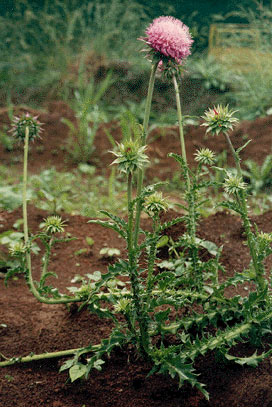
Carduus nutans, with the common names musk thistle, nodding thistle, and nodding plumeless thistle, is a biennial plant in the daisy and sunflower family Asteraceae. It is native to regions of Eurasia.

Onopordum, or cottonthistle, is a genus of plants in the tribe Cardueae within the family Asteraceae. They are native to southern Europe, northern Africa, the Canary Islands, the Caucasus, and southwest and central Asia. They grow on disturbed land, roadsides, arable land and pastures.

Carduus is a genus of flowering plants in the family Asteraceae, and the tribe Cardueae, one of two genera considered to be true thistles, the other being Cirsium. Plants of the genus are known commonly as plumeless thistles. They are native to Eurasia and Africa, and several are known elsewhere as introduced species. This genus is noted for its disproportionately high number of noxious weeds compared to other flowering plant genera.

Thistle is the common name of a group of flowering plants characterised by leaves with sharp prickles on the margins, mostly in the family Asteraceae. Prickles can also occur all over the plant – on the stem and on the flat parts of the leaves. These prickles are an adaptation that protects the plant from being eaten by herbivores. Typically, an involucre with a clasping shape similar to a cup or urn subtends each of a thistle's flower heads. The typically feathery pappus of a ripe thistle flower is known as thistle-down.
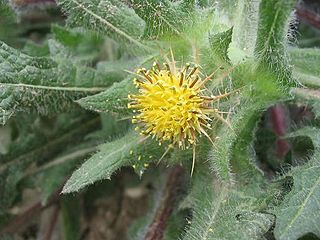
Centaurea benedicta, known by the common names St. Benedict's thistle, blessed thistle, holy thistle and spotted thistle, is a thistle-like plant in the family Asteraceae, native to the Mediterranean region, from Portugal north to southern France and east to Iran. It is known in other parts of the world, including parts of North America, as an introduced species and often a noxious weed.
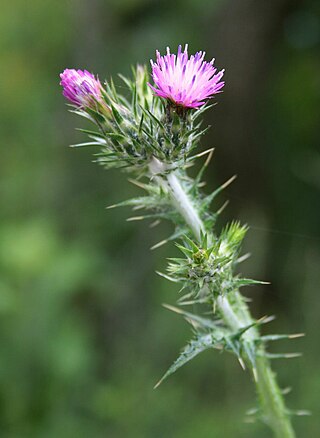
Carduus pycnocephalus, with common names including Italian thistle, Italian plumeless thistle, and Plymouth thistle, is a species of thistle. It is native to the Mediterranean region in southern Europe, North Africa, and Western Asia; Eastern Europe and the Caucasus; and the Indian Subcontinent.

The Cardueae are a tribe of flowering plants in the daisy family (Asteraceae) and the subfamily Carduoideae. Most of them are commonly known as thistles; four of the best known genera are Carduus, Cynara, Cirsium, and Onopordum.

Carduus crispus, the curly plumeless thistle or welted thistle, is a biennial herb in the daisy family Asteraceae. C. crispus is native to multiple different countries all over Europe and Asia, but it is also naturalized in North America. These plants have specific environmental conditions such as the type of soil and the amount of sunlight that must be met before they can grow. There is a breakdown of the species Carduus crispus that tells us the origin and the meaning of each part of the species' name. The leaves, flowers and fruit of this species are described, as well as, the medicinal and wildlife uses.
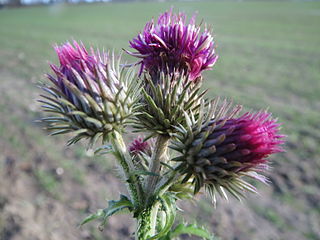
Carduus acanthoides, known as the spiny plumeless thistle, welted thistle, or plumeless thistle, is a biennial plant species of thistle in the family Asteraceae. The plant is native to Europe and Asia and introduced in many other areas, where it is sometimes considered an invasive species.
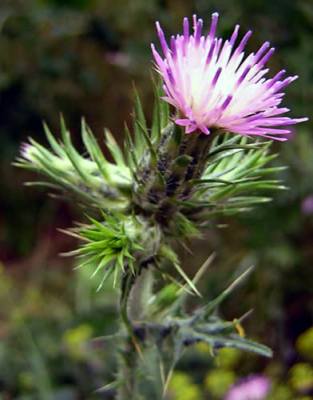
Carduus tenuiflorus, known variously as slender-flower thistle, sheep thistle, shore thistle, slender thistle, winged plumeless thistle, winged slender thistle and winged thistle, is a species of flowering plant in the family Asteraceae. It is native to Europe and North Africa, and an introduced species elsewhere.
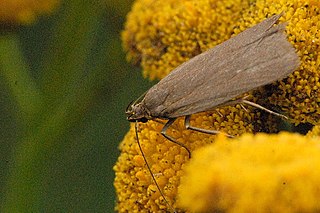
Scrobipalpa acuminatella is a moth of the family Gelechiidae. It is found in most of Europe, as well as Turkey, southern Siberia, Central Asia and China (Anhui). It was recently reported from Canada, with records from Ontario and Québec.

Zygaena lonicerae, the narrow-bordered five-spot burnet, is a moth of the family Zygaenidae. The species was first described by Theodor Gottlieb von Scheven in 1777.
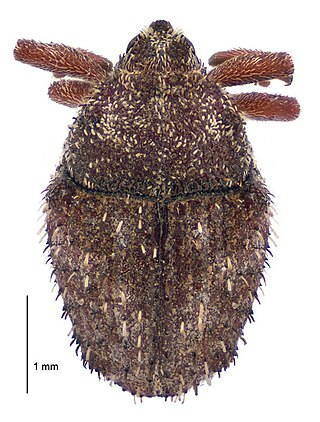
Trichosirocalus horridus is a species of true weevil, native to Europe. It is a biological pest control agent that was introduced into the United States in 1974 to control exotic thistles, especially in the Cirsium and Carduus genera.

Jordanita chloros is a moth of the family Zygaenidae.
Jordanita graeca is a moth of the family Zygaenidae. It is found from southern Slovakia through Hungary, the Balkan Peninsula, Rhodes and Cyprus to southern Russia, Ukraine, Transcaucasia, Turkey, Iran and northern Iraq.
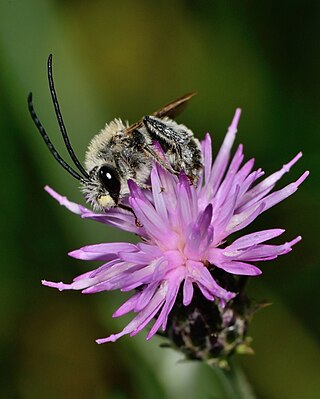
Carduus argentatus, sometimes known as the silver thistle, is an annual herb in the family Asteraceae. As a member of the genus Carduus it is known as a plumeless thistle. It is found throughout the Mediterranean and Middle East. Frequently growing in disturbed habitats, it is often found in sandy and stony desert wadis. It is found in the eastern deserts of Egypt, through the East Mediterranean region and into Iraq, Pakistan and Afghanistan. It can be found growing in open woodlands and shrublands, on steppes and semi-steppes as well as in extreme desert conditions. It grows among mountain vegetation on Mount Hermon in the Golan Heights. In Crete it is found at altitudes of up to 1,400 metres (4,600 ft).

Terellia serratulae is a species of tephritid or fruit flies in the family Tephritidae.

Brachycaudus cardui is a species of aphid, commonly known as the thistle aphid or the plum-thistle aphid. It infests trees in the genus Prunus in the spring and autumn, and mostly plants in the aster family in the summer.

Larinus turbinatus is a species of true weevil in the family of beetles known as Curculionidae.

















